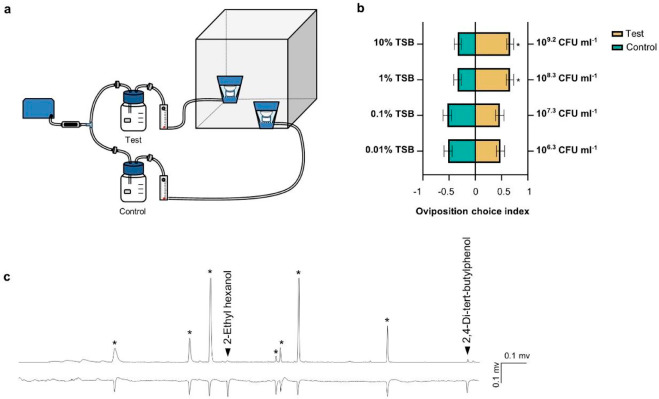Acta Tropica, Volume 237, January, 2023
Highlights
- Volatile organic compounds produced by Klebsiella sp. elicited oviposition and antennal responses in the arboviral vector Aedes aegypti.
- A binary blend based on Klebsiella sp. odors was able to recapitulate the egg-laying responses of gravid mosquitoes.
- The detection of Klebsiella sp. volatiles relies on the odorant receptor pathway since an orco mutant strain of Ae. aegypti lacked behavioral and physiological responses.
- Bacteria-associated volatiles could be used to exploit mosquito behavior for population surveillance and vector control strategies.
Abstract
Complex oviposition decisions allow gravid Aedes aegypti mosquitoes to select suitable sites for egg-laying to increase the probability that their progeny will thrive. The bacterial communities present in larval niches influence mosquito oviposition behavior, and gravid mosquitoes transmit key microbial associates to breeding sites during oviposition. Our study evaluated whether symbiotic Klebsiella sp., which are strongly associated with mosquitoes, emit volatiles that affect mosquito oviposition decisions. Dual-choice behavioral assays demonstrated that volatile organic compounds emitted by Klebsiella sp. induce a preference in oviposition decisions by Ae. aegypti. Bacterial headspace volatiles were sampled by solid-phase microextraction, and subsequent combined gas chromatography and electroantennogram detection analysis, revealed that the antennae of gravid females detect two compounds present in the Klebsiella sp. headspace. These compounds were identified by gas chromatography and mass spectrometry as 2-ethyl hexanol and 2,4-di‑tert-butylphenol. The binary blend of these compounds elicited a dose-dependent egg-laying preference by gravid mosquitoes. We propose that bacterial symbionts, which are associated with gravid mosquitoes and may be transferred to aquatic habitats during egg-laying, together with their volatiles act as oviposition cues indicating the suitability of active breeding sites to conspecific females.
Klebsiella sp.; Bacterial volatiles; Olfaction; Chemical ecology; Oviposition

